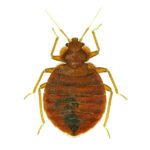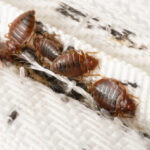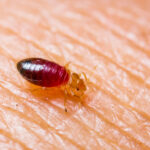How Can We Help?
What do bedbugs look like?
Bedbugs are small, reddish-brown insects, usually around 4 or 5 millimeters long and 1.5 to 3 millimeters wide when they haven't fed. They have flat, oval-shaped bodies, perfect for hiding in narrow spaces. After a meal, they swell up and become more elongated and reddish. They have six legs and two short, clubbed antennae. Without wings, they can't fly but can move quickly over floors, walls, and ceilings.
Their heads are short and broad with noticeable compound eyes, and they have a distinct beak-like structure called a proboscis to bite the skin and suck blood. This proboscis tucks under their bodies when not in use. Although they have small, vestigial wing pads, these don't turn into functional wings.
Bedbugs might be mistaken for other small bugs like carpet beetles or young cockroaches, but their unique shape, lack of wings, and behavior help identify them correctly.
Bedbug eggs are tiny, white, and oval-shaped, about 1 millimeter long, and hard to spot without magnification. Found in clusters in cracks and crevices where adults hide, these eggs hatch into nymphs that look like smaller versions of adults. As they grow, they gradually take on the reddish-brown color.
How can you tell if you've been bitten by bedbugs?
Identifying bedbug bites can be tricky since they often look like bites from other insects or skin conditions. But there are a few telltale signs to watch for. Bedbug bites usually show up as small, red, swollen bumps with a darker red center. They're often lined up or clustered together, commonly called "breakfast, lunch, and dinner" patterns, because bedbugs like to feed multiple times on exposed skin.
Bites usually happen on parts of your body that are exposed while you sleep, like your face, neck, arms, hands, and legs. Unlike flea bites, which are usually around your ankles, bedbug bites can be found anywhere that's not covered by clothing.
People react differently to bedbug bites. Some might have intense itching, swelling, and redness, while others might barely notice them. The bites can take a few days to show up after you've been bitten, making it hard to figure out the source right away. Itching is common and can get pretty bad, leading to scratching and possibly secondary infections.
Another way to spot bedbug bites is by looking for other signs of an infestation. This includes actually finding bedbugs, seeing small reddish-brown fecal spots on your bedding, sheets, or mattress, and finding shed skins or eggs in cracks and seams. You might also notice a sweet, musty smell in heavily infested areas.
How do the physical features of bedbugs change after a blood meal?
Bedbugs go through noticeable changes after a blood meal, which helps identify them and understand their behavior. Before feeding, bedbugs are small, flat, and oval-shaped, usually about 4 to 5 millimeters long. They have reddish-brown, thin bodies, similar to an apple seed. This flat shape allows them to hide in narrow crevices and cracks during the day.
Once they feed, bedbugs change significantly in both size and color. Feeding lasts between 5 to 10 minutes, during 
In addition to size changes, the color of a bedbug's body changes after feeding. The blood meal turns their previously translucent, reddish-brown bodies into a darker, deeper red hue. This color change is due to the blood filling their digestive system, which shows through their semi-transparent exoskeleton.
These physical changes make it easier to tell apart fed and unfed bedbugs. The post-feeding look—larger, more elongated, and darker—indicates that the bedbug has recently had a blood meal. These changes also affect their behavior; engorged bedbugs are slower and less agile, making them easier to spot and capture.
How do the physical features of bedbugs change as they go through their life cycle?
Bedbugs undergo distinct physical changes throughout their life cycle, which consists of five nymphal stages (instars) before reaching adulthood. The cycle of life begins with the hatching of eggs, which are tiny, white, and about 1 millimeter in length. Newly hatched nymphs are nearly colorless, small, and translucent, measuring about 1.5 millimeters. As they progress through each instar, nymphs must consume a blood meal to molt and grow to the next stage.
During each molt, nymphs shed their exoskeleton, growing larger and gradually darkening in color. After the first molt, nymphs are still quite small but begin to show a light yellow or tan hue. With each successive stage, they continue to increase in size, becoming more robust and taking on a darker coloration. By the fifth instar, nymphs are nearly the size of adult bedbugs, measuring about 4 to 5 millimeters, and exhibit a more pronounced reddish-brown color.
Adult bedbugs are approximately 5 to 7 millimeters long and have a flattened, oval shape. Their bodies are a reddish-brown color, which becomes more pronounced after feeding. Adults have a more developed, harder exoskeleton compared to nymphs, making them more durable. Both nymphs and adults possess six legs, two antennae, and a distinct proboscis for piercing and sucking blood, but adults have more defined and darker features.
Throughout their life cycle, bedbugs retain the same basic body structure but undergo significant size and color
